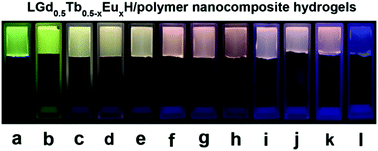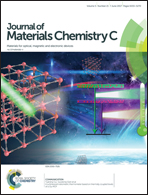Tunable photoluminescence from layered rare-earth hydroxide/polymer nanocomposite hydrogels by a cascaded energy transfer effect†
Abstract
Polymer/inorganic nanocomposite (NC) hydrogels usually display super mechanical properties, due to their 3D crosslinked network of delaminated inorganic nanoparticles and polymers as well as strong interfacial interactions. Multiple functions including photoluminescence are strongly desired for their applications. In this study, we report layered rare-earth hydroxide (LRH)/polyacrylamide NC hydrogels with highly colour-tunable photoluminescence functions by a cascaded energy transfer effect. These NC hydrogels based on LRHs containing Gd3+, Tb3+ or Eu3+ ions are fabricated via a convenient and green in situ polymerization procedure. Diverse photoluminescent colours are clearly observed, ranging from green, yellow-green, yellow, reddish-orange, yellowish pink, pink to bluish violet. Furthermore, these NC hydrogels exhibit long luminescence lifetimes and high quantum efficiencies. More interestingly, such fascinating photoluminescence features are highly tunable by varying the constituent or concentration of LRHs, and the excitation wavelength. Finally, a cascaded energy transfer pathway is proposed to elucidate the molecular mechanism of the tunable multiple-colour photoluminescence functions, i.e. the LRH host → sensitizer sodium salicylate (SA) → Tb3+, and finally Tb3+ → Eu3+.



 Please wait while we load your content...
Please wait while we load your content...